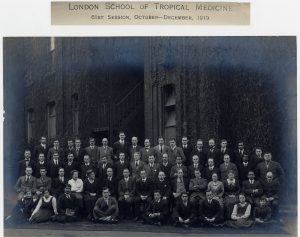As we welcome new students to the London School of Hygiene & Tropical Medicine, it seems appropriate that we reflect on the students who attended 100 years ago, the class of 1919.
The 61st session ran from October to December. 52 students attended the School, of these 46 were men and 6 were women. They came from the following services:
- Colonial Service: 9
- Indian Medical Service: 3
- Australian Army: 3
- Missions: 12
- Private: 16
The School’s student registers record a number of details about the students including their destination on leaving, the majority of students went to Africa (15), and the next most popular destination was India (5) but students ended up all over the world including China, West Indies, Syria, South America and Australia.
At this time the School was part of the Seaman’s Hospital Society and was based in the Albert Docks in the East End, along with the Hospital for Tropical Diseases. This was so students had access to seamen suffering from tropical diseases who had arrived back from overseas on their boats which docked in the Thames. The school offered facilities for study and research, including laboratories and insectaries that provided students with the opportunities to develop and share their knowledge. There was also an emphasis that students would not only learn how to identify and treat tropical disease but would also gain the skills to investigate illnesses.
This was the last session of the School held at the Albert Dock site as the School moved to Endsleigh Gardens in early 1920.
In 1919, the School still employed women as laboratory assistant roles, these are shown in the group photo and were called Louise, Alice, Lucy and Eva. These laboratory assistants were employed for the first time in December 1915. Usually the position of laboratory assistants was given to men, however, due to conscription during the First World War the number of men available to work dropped dramatically, which encouraged employers, to employ women.
Among the students there were at least two individuals who went on to work for the School.
Dr James T Duncan was born in Ireland in 1884; educated at schools in Dublin and Watford and attended Dublin Royal College of Physicians and Surgeons. Post qualification, Duncan spent a year visiting Medical Colleges in the United States and Canada and was appointed lecturer in anatomy at the Edward VII Medical School, Malaya, 1914; later becoming Acting Principal of the Edward VII Medical School, 1916. He returned to England and took a course at the London School of Tropical Medicine, later being appointed as assistant to Dr Newham.
Duncan was attached to the Bacteriological Department at LSHTM from 1929, studying the Salmonella and Brucella groups, having already demonstrated skill in this field, in 1922, by separating Brucella abortus from man, the first published record of this. Duncan was moved to Winchester with the Emergency Medical services in 1939, and became Chairman of the Medical Research Council Committee on Mycology, initiating a movement for the establishment of a centre for Medical Mycology in London, which was later established at LSHTM. Duncan was appointed as Reader in Mycology to the University of London, 1945 and formed active centres of mycology in Leeds, Exeter, Glasgow and Birmingham Universities. Duncan retired in 1949.
Dr Neil Hamilton Fairley (1891-1966) was born in Australia and qualified at Melbourne University in 1915. He worked in Egypt during the First World War on typhus fever and schistosomiasis and came to the London School to study in 1919. He returned to Australia to work at the Walter and Eliza Hall Institute of Medicine, interrupted by three years in Bombay where he returned to schistosomiasis studies. He returned to Australia in 1925 and then joined the School as Lecturer and the Hospital of Tropical Diseases as Assistant Physician in 1929. World War Two saw Fairley’s most distinguished contributions to medical science and to malaria research in the field: the setting up of research groups at Cairns, and convincing both authorities and serving personnel of the need for regular daily doses of atebrin as preventive medication. Back in London in 1946, Fairley took up the newly created Wellcome Chair of Tropical Medicine at LSHTM but was forced to resign in 1950 due to ill health.
For further information on the history of the School, please contact the Archives Service at archives@lsthm.ac.uk



